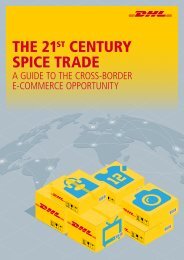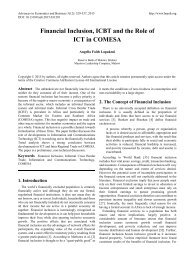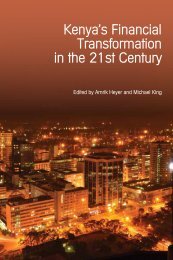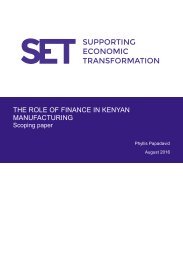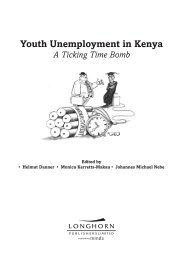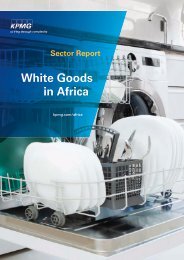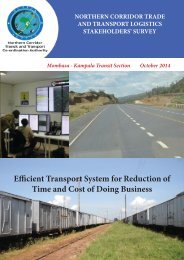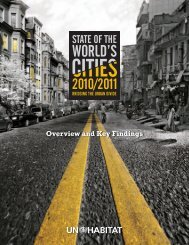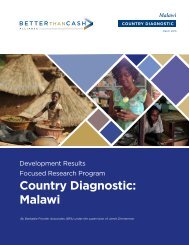FD
gvti301SEaf
gvti301SEaf
Create successful ePaper yourself
Turn your PDF publications into a flip-book with our unique Google optimized e-Paper software.
HIV/AIDS. And the preponderance of academic research in<br />
recent years concludes that aid has helped accelerate growth<br />
on average and consolidate democracy in some countries,<br />
especially since the mid-1990s (for a good recent summary of<br />
this research, see Arndt, Jones, and Tarp, 2015).<br />
The view that Africa’s surge happened only because of the<br />
commodity price boom is too simplistic. It overlooks the acceleration<br />
in growth that started in 1995, seven years before commodity<br />
prices rose; the impact of commodity prices, which<br />
varied widely across countries (and hurt oil importers); and<br />
changes in governance, leadership, and policy that were critical<br />
catalysts for change. This broader understanding of the drivers<br />
of progress is crucial in considering the prospects for the<br />
future: sub-Saharan Africa’s long-term future will not be determined<br />
by the vagaries of the commodity markets alone, but by<br />
how well these and other challenges are managed.<br />
Choppy waters<br />
However, global circumstances have changed significantly,<br />
and many countries are confronting some of their most difficult<br />
challenges in a decade or more. Growth has slowed significantly<br />
around the world, including in several important<br />
export markets. Growth in Europe has slowed sharply, and<br />
the U.S. recovery remains modest. As growth has slowed, so<br />
has trade. World trade expanded by nearly 7 percent a year in<br />
the decade between 1998 and 2007, but since 2012 the pace<br />
has fallen by more than half to just 3 percent a year.<br />
Perhaps most important, China’s growth has dropped to<br />
about 6 percent, well below the pace of recent years. China’s<br />
trade with sub-Saharan Africa exploded from less than $20 billion<br />
in 2003 to more than $170 billion in 2013. But China’s<br />
weakened growth and its efforts to put greater emphasis on its<br />
domestic economy have led to a sharp slowdown in trade with<br />
Africa and a significant contraction in some countries, especially<br />
Angola, the Republic of Congo, Equatorial Guinea, South<br />
Africa, and Zambia—China’s main African trading partners.<br />
The changes are not all negative: the rapid rise in wages in China<br />
creates new opportunities for African countries to expand manufacturing.<br />
But the relationships with China are again changing<br />
rapidly, and managing them carefully will be central to continued<br />
long-term growth in many countries across the region (see<br />
“A Fork in the Road,” in this issue of F&D).<br />
With growth slowing, commodity prices have dropped significantly.<br />
The prices of corn, copper, and cotton have all fallen<br />
by more than 20 percent since 2013, and iron ore and oil prices<br />
have dropped more than 50 percent. These declines have had<br />
a wide-ranging impact on export earnings, budget revenues,<br />
investment, employment, exchange rates, and foreign exchange<br />
reserves. The effects are particularly large in the oil producers<br />
(Angola, Republic of Congo, and Nigeria, among others) and<br />
in countries that export iron ore (Liberia, Sierra Leone, South<br />
Africa), copper (Republic of Congo, South Africa, Zambia),<br />
and diamonds (Botswana, Namibia, South Africa).<br />
Correspondingly, growth in sub-Saharan Africa slowed<br />
from 5 percent in 2014 to 3.5 percent in 2015, and the IMF<br />
projects that it will remain subdued at 3 percent in 2016.<br />
Once again, there is wide variation, with some countries hit<br />
hard and others actually benefiting from price changes (see<br />
Chart 3). Oil exporters have seen the biggest drop in growth,<br />
alongside iron ore, copper, and diamond producers. South<br />
Africa, one of the region’s major economic engines, has been<br />
rocked by drought, falling export prices, and growing political<br />
struggles, and growth is now only about 1 percent. In<br />
Nigeria, the other regional powerhouse, last year’s successful<br />
political transition was followed by immediate challenges<br />
stemming from the steep decline in oil prices, widening fiscal<br />
and trade imbalances, and a hesitant response from policymakers.<br />
Angola, Liberia, and Zambia also have been hit hard.<br />
By contrast, most sub-Saharan African countries are oil<br />
importers, and they have benefited from the drop in fuel<br />
Radelet, corrected 04/15/20106<br />
prices. Some countries, such as CÔte d’Ivoire, have gained<br />
both from a rise in export prices (in this case, cocoa) and the<br />
drop in oil import prices. Similarly, many countries are food<br />
importers and have been helped by the decline in prices for<br />
rice, wheat, and other food products. Countries with more<br />
diversified exports are experiencing a more moderate impact<br />
on export prices, coupled with gains on the import side.<br />
Chart 2<br />
Straight and narrow<br />
Democracy has spread in sub-Saharan Africa, and governance<br />
has improved.<br />
(governance, global percentile ranking,<br />
(number of electoral democracies) 2014)<br />
25<br />
50<br />
20<br />
15<br />
10<br />
5<br />
10<br />
0<br />
1989 Radelet, corrected 99 04/19/20106 0<br />
2009<br />
Sources: Freedom House, Freedom in the World—Electoral Democracies; World Bank<br />
Institute, Worldwide Governance Indicators.<br />
Note: SSA = sub-Saharan Africa.<br />
Chart 3<br />
Downshift<br />
Growth in Africa has slowed, but large differences remain across<br />
countries.<br />
(GDP growth, percent)<br />
7<br />
Oil-importing countries (excluding South Africa)<br />
6<br />
5<br />
4<br />
3<br />
2<br />
1<br />
South Africa<br />
Oil-exporting countries<br />
All SSA<br />
Electoral<br />
democracies<br />
Nondemocracies<br />
Oil exporters<br />
Sub-Saharan Africa<br />
0<br />
2012 13 14 15 16 17<br />
Source: IMF, Regional Economic Outlook: Sub-Saharan Africa, May 2016. Figures for<br />
2016 and 2017 are projections.<br />
40<br />
30<br />
20<br />
Central America<br />
South Asia<br />
Finance & Development June 2016 9



